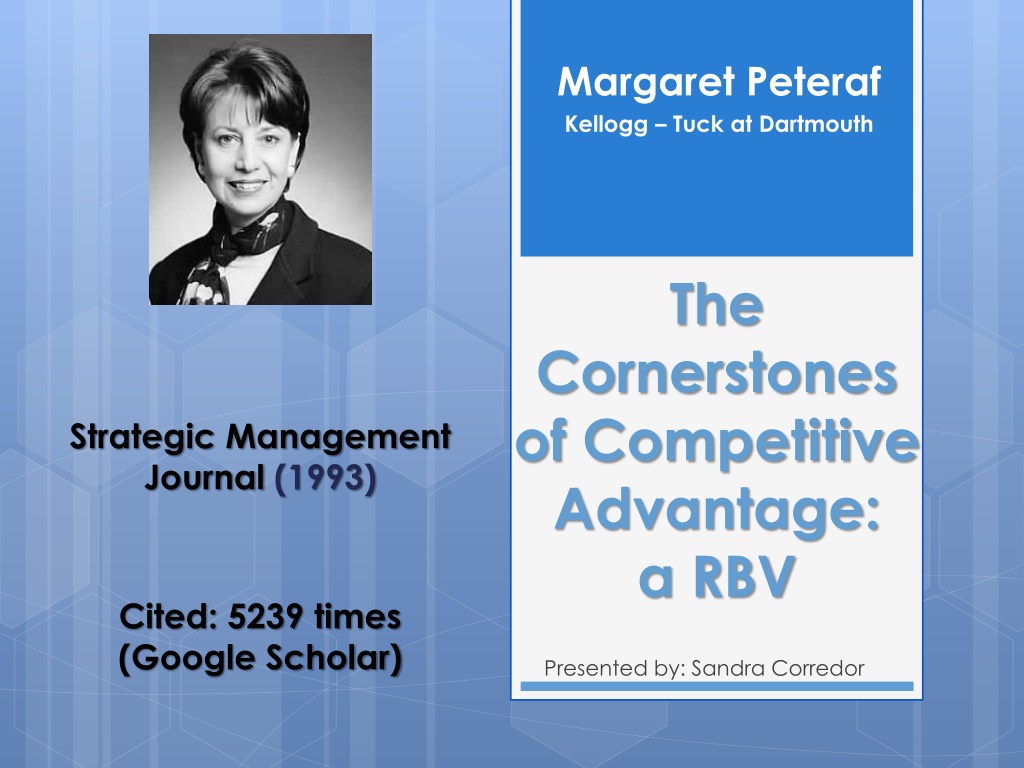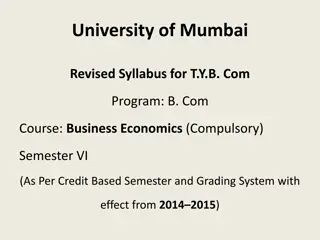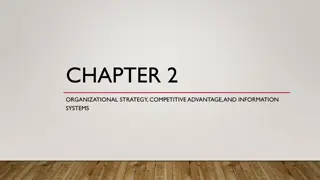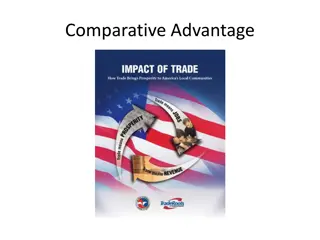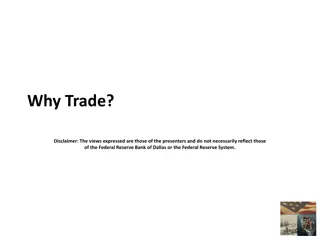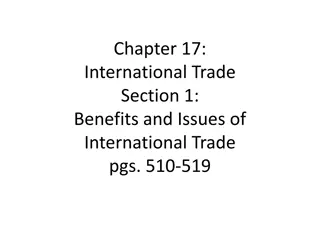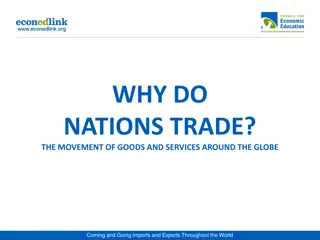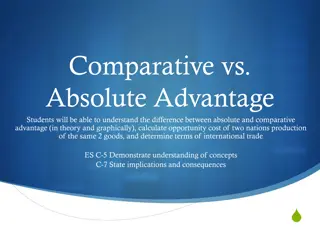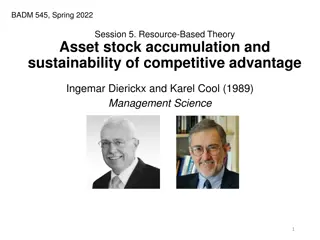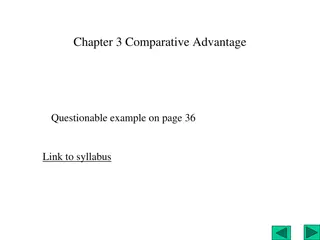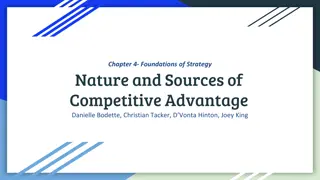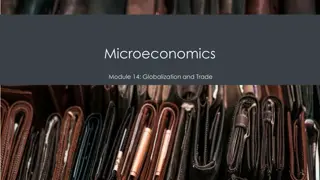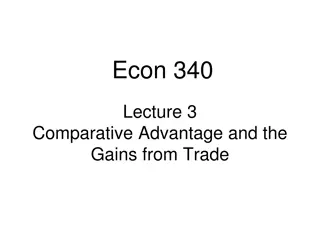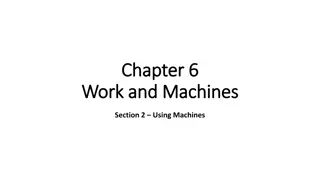Understanding the Resource-Based View Model for Competitive Advantage
Exploring the Resource-Based View (RBV) model by Margaret Peteraf, this content delves into the origins of heterogeneity, valuable resources, and sustainable competitive advantage. It highlights four necessary conditions for gaining a competitive edge and discusses the concept of Ricardian Rent in enhancing firm productivity and competitiveness.
Download Presentation

Please find below an Image/Link to download the presentation.
The content on the website is provided AS IS for your information and personal use only. It may not be sold, licensed, or shared on other websites without obtaining consent from the author. Download presentation by click this link. If you encounter any issues during the download, it is possible that the publisher has removed the file from their server.
E N D
Presentation Transcript
Margaret Peteraf Kellogg Tuck at Dartmouth The Cornerstones of Competitive Advantage: a RBV Strategic Management Journal (1993) Cited: 5239 times (Google Scholar) Presented by: Sandra Corredor
Motivation Integration of the RBV model terminology and ideas: general model of resources and firm ability to generate rents and sustainable rents. RBV complements the firm effect analysis (as opposed to the industry effect) Understanding: What are the origins of heterogeneity What is the nature of valuable resources and rents What is the relationship of resources with competitive advantage and what makes a competitive advantage sustainable.
Four individual-necessary-conditions for Competitive Advantage 1. Resource heterogeneity from which come Ricardian or monopoly rents. Value & Rare = heterogeneity TOGETHER THEY ARE SUFFICIENT CONDITIONS TO C.A. 2. Ex post limits to competition are necessary to sustain the rents. Inimitable. Non-perfect substitutability. 3. Imperfect Mobility: Perfectly immobile, or imperfectly mobile due to firm-specific investments. 4. Ex ante limits to competition prevent costs from offsetting the rents
Ricardian Rent Presence of superior productive factors which are in limited supply. May be fixed factors which cannot be expanded. More often, they are quasi-fixed: their supply cannot be expanded rapidly or without cost. Characteristics: Competitive behavior in the product market (firms are price-takers) Inelastic supply curves: they cannot expand output rapidly, regardless of how high the price may be. High prices, however, do induce other less efficient firms to enter the industry. Entrants will produce so long as P exceeds their marginal cost (MC). In equilibrium, industry demand and supply are in balance, high- cost firms breakeven (P = AC), and low-cost firms earn supra-normal profits in the form of rents to their scarce resources (P > AC). Not a market power theory (i.e. no restriction of output, no uniqueness or rareness on output).
Ricardian Rent While superior productive factors might be limited in the short run, they may be renewed and expanded incrementally within the firm that utilizes them (Wernerfelt, Nelson & Winter). Utilization of such resources may in fact augment them: i.e. learning. Superior resources provide basis and direction of growth: path dependencies. Current capabilities may both drive and constrain future learning and investment activity
Heterogeneity Heterogeneity = origin or rents Heterogeneity implies that firms of varying capabilities are able to compete in the marketplace and, at least, breakeven Sources: Ricardian rents Monopoly rents: deliberate restriction of output. Spatial competition or product differentiation. Imply intra-industry mobility barriers, size advantages, irreversible commitments or other first mover advantage. Asymmetries must exist between incumbent and potential entrants. Homogeneous firms may also earn monopoly rents (Cournot behavior).
Ex-post limits Ex-post limits to competition = Durability of heterogeneity Competition may: Increase the supply of scarce resources: makes industry supply more elastic. Undermine a monopolist's (or oligopolists') attempts to restrict output: makes individual demand curves more elastic. Imperfect imitability: Rumelt s isolating mechanisms to isolate groups of similar firms in heterogeneous industries. Rights & Quasi-rights to scarce resources: lags, info. asymmetries, frictions. Producer learning, buyer switching costs, reputation, buyer search costs, channel crowding, and economies of scale when specialized assets. Failures of competitive market due to: TC and info. asymmetries (Yao, 1988); time compression diseconomies, asset mass efficiencies, interconnectedness of asset stocks, and asset erosion (Dierickx and Cool, 1989) Imperfect substitutability: Porter s five forces Causal ambiguity (Lippman and Rumelt, 1982): Uncertainty regarding the causes of efficiency differences among firms. Not sufficient condition: must be coupled with non-recoverable costs.
Ex-post limits Ex-post limits to competition = Durability of heterogeneity Competition may: Increase the supply of scarce resources: makes ind. supply more elastic. For the most part, ex post limits to competition imply heterogeneity, although heterogeneity does not imply ex post limits to competition Undermine a monopolist's (or oligopolists') attempts to restrict output: makes individual demand curves more elastic. Imperfect imitability: Rumelt s isolating mechanisms to isolate groups of similar firms in heterogeneous industries. Rights & Quasi-rights to scarce resources: lags, info. asymmetries, frictions. Producer learning, buyer switching costs, reputation, buyer search costs, channel crowding, and economies of scale when specialized assets. Failures of competitive market due to: TC and info. asymmetries (Yao, 88); time compression diseconomies, asset mass efficiencies, interconnectedness of asset stocks, and asset erosion (Dierickx and Cool, 89) Imperfect substitutability: Porter s five forces Causal ambiguity (Lippman and Rumelt, 82): Uncertainty regarding the causes of efficiency differences among firms. Not sufficient condition: must be coupled with non-recoverable costs.
Imperfect mobility Imperfect mobility = Sustainability of rents Opportunity cost of asset use is significantly less than their value to the present employer. Pareto rents i.e. Quasi-rents: the excess of an asset's value over its salvage value or its value in its next best use. Perfectly immobile: completely bounded to the firm. Property rights are not well defined or with 'bookkeeping feasibility' problems (Dierickx and Cool 1989) Idiosyncratic resources: they have no other use outside the firm Imperfectly mobile: tradable but more valuable within the firm that currently employs them. Switching costs (Montgomery and Wernerfelt 1988): firm specific investments that cement the trading relationship between a firm and the owners of factors. Sunk costs. High transaction costs also lead to imperfect mobility (Williamson 1975; Rumelt 1987) Co-specialized assets (Teece 1986): must be used in conjunction with one another or have higher economic value when employed together.
Imperfect mobility Imperfect mobility = Sustainability of rents requires appropriability Appropriable quasi-rents or A-Q rents : the excess of an asset's value over its value to the second highest valuing potential user or bidder for the resource (Klein et al. 78). NOT a sufficient condition for value. It is entirely possible for a resource to generate AQ rents in the absence of either Ricardian or monopoly rents. Differential value to possible users: Rare Inimitable Other contingencies that are not source of competitive advantage (?) A-Q rents as competitive advantage: differential value is appropriable a firm can appropriate AQ rents AQ rents are also Ricardian or monopoly rents. Producer can fully appropriate quasi-rents (Williamson s V.I.) Bilateral monopoly: 50-50 rent distribution The firm and the factor are a team (Teece s co-especialization)
Imperfect mobility Imperfect mobility = Sustainability of rents requires appropriability Appropriable quasi-rents or A-Q rents : the excess of an asset's value over its value to the second highest valuing potential user or bidder for the resource (Klein et al. 78). Again heterogeneous resources need not be imperfectly mobile. But it is hard to imagine any imperfectly mobile resources which are not also heterogeneous in nature. NOT a sufficient condition for value. It is entirely possible for a resource to generate AQ rents in the absence of either Ricardian or monopoly rents. Differential value to possible users: Rare Inimitable Other contingencies that are not source of competitive advantage A-Q rents as competitive advantage: differential value is appropriable a firm can appropriate AQ rents AQ rents are also Ricardian or monopoly rents. Producer can fully appropriate quasi-rents (Williamson s V.I.) Bilateral monopoly: 50-50 rent distribution The firm and the factor are a team (Teece s co-specialization)
Ex-ante limits Ex-ante limits to competition = Space for creation of rents Prior to any firm's establishing a superior resource position, there must be limited competition for that position. Imperfections in the strategic factor market. Barney 86: returns from their strategies but also on the cost of implementing those strategies. Profits come from ex ante uncertainty of the ex-post value of a venture Uncertainty is solved favorably by luck or foresight. Ex ante competition to develop strategic factor and/or imperfectly mobile resources (eg. reputation). Demand: Value concept in Barney (91)?
Application The Scope of the Firm SINGLE BUSINESS STRATEGY CORPORATE BUSINESS STRATEGY Differentiate between resources which might support a competitive advantage from other less valuable resources. Boundaries of the firm Extent of diversification: excess capacity in a multiple-use resource, under a market failure. Sourcing choice: whether to license a new technology or whether to develop it internally. Two problematic issues: 1. How excess capacity in resources may lead to scarcity rents for resource holders?: single product mkt. Identify how imitable is firm s innovation: develop/buy appropriability mechanisms. 2. Why firms do not expand more fully in initial markets before they enter additional ones?: 'specificity' or range of application & set of market opportunities. In sum: how to target, develop & deploy assets (Amit&Schoemaker 1993)
Some notes Identifies commonalities on RBV. Main assumptions for this explanation of Ricardian rents: long run, and no externalities. What about co-existence of long term vs. short term what could be the implications for rents?
